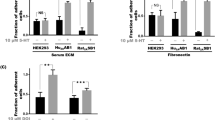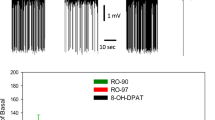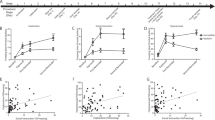Abstract
Serotonin 2C receptor (5-HT2CR) exerts a major inhibitory influence on dopamine (DA) neurotransmission within the mesocorticolimbic DA pathway that is implicated in drug reward and goal-directed behaviors. 5-HT2CR pre-mRNA undergoes adenosine-to-inosine editing, generating numerous receptor isoforms in brain. As editing influences 5-HT2CR activity, individual differences in editing might influence dopaminergic function and, thereby, contribute to interindividual vulnerability to drug addiction. Liability to drug-related behaviors in rats can be predicted by their level of motor activity in response to a novel environment. Rats with a high locomotor response (high responders; HRs) exhibit enhanced acquisition and maintenance of drug self-administration compared to rats with a low response (low responders; LRs). We here examined 5-HT2CR mRNA editing and expression in HR and LR phenotypes to investigate the relationship between 5-HT2CR function and behavioral traits relevant to drug addiction vulnerability. Three regions of the mesocorticolimbic circuitry (ventral tegmental area (VTA), nucleus accumbens (NuAc) shell, and medial prefrontal cortex (PFC)) were examined. 5-HT2CR mRNA expression and editing were significantly higher in the NuAc shell compared with both the PFC and VTA, implying significant differences in function (including constitutive activity) among 5-HT2CR neuronal populations within the circuitry. The regional differences in editing could, at least in part, arise from the variations in expression levels of the editing enzyme, ADAR2, and/or from the variations in the ADAR2/ADAR1 ratio observed in the study. No differences in the 5-HT2CR expression were detected between the behavioral phenotypes. However, editing was higher in the PFC of HRs vs LRs, implicating this region in the pathophysiology of drug abuse liability.
Similar content being viewed by others
Log in or create a free account to read this content
Gain free access to this article, as well as selected content from this journal and more on nature.com
or
Accession codes
References
Arsenault-Lapierre G, Kim C, Turecki G (2004). Psychiatric diagnoses in 3275 suicides: a meta-analysis. BMC Psychiatry 4: 37.
Bass BL (2002). RNA editing by adenosine deaminases that act on RNA. Annu Rev Biochem 71: 817–846.
Berg KA, Clarke WP, Cunningham KA, Spampinato U (2008). Fine-tuning serotonin(2c) receptor function in the brain: molecular and functional implications. Neuropharmacology 55: 969–976.
Berg KA, Cropper JD, Niswender CM, Sanders-Bush E, Emeson RB, Clarke WP (2001). RNA-editing of the 5-HT(2C) receptor alters agonist–receptor–effector coupling specificity. Br J Pharmacol 134: 386–392.
Bubar MJ, Cunningham KA (2007). Distribution of serotonin 5-HT2C receptors in the ventral tegmental area. Neuroscience 146: 286–297.
Burns CM, Chu H, Rueter SM, Hutchinson LK, Canton H, Sanders-Bush E et al (1997). Regulation of serotonin-2C receptor G-protein coupling by RNA editing. Nature 387: 303–308.
Canton H, Emeson RB, Barker EL, Backstrom JR, Lu JT, Chang MS et al (1996). Identification, molecular cloning, and distribution of a short variant of the 5-hydroxytryptamine2C receptor produced by alternative splicing. Mol Pharmacol 50: 799–807.
Carr DB, Sesack SR (2000). GABA-containing neurons in the rat ventral tegmental area project to the prefrontal cortex. Synapse 38: 114–123.
De Deurwaerdere P, Navailles S, Berg KA, Clarke WP, Spampinato U (2004). Constitutive activity of the serotonin2C receptor inhibits in vivo dopamine release in the rat striatum and nucleus accumbens. J Neurosci 24: 3235–3241.
de Wit H, Uhlenhuth EH, Johanson CE (1986). Individual differences in the reinforcing and subjective effects of amphetamine and diazepam. Drug Alcohol Depend 16: 341–360.
Di Giovanni G, Di M, V, Esposito E (2002). Serotonin/dopamine interaction--focus on 5-HT2C receptor, a new target of psychotropic drugs. Indian J Exp Biol 40: 1344–1352.
Di Matteo V, Pierucci M, Esposito E (2004). Selective stimulation of serotonin2c receptors blocks the enhancement of striatal and accumbal dopamine release induced by nicotine administration. J Neurochem 89: 418–429.
Dracheva S, Byne W, Chin B, Haroutunian V (2008a). Ionotropic glutamate receptor mRNA expression in the human thalamus: absence of change in schizophrenia. Brain Res 1214: 23–34.
Dracheva S, Chin B, Haroutunian V (2008b). Altered serotonin 2C receptor RNA splicing in suicide: association with editing. NeuroReport 19: 379–382.
Dracheva S, Elhakem SL, Marcus SM, Siever LJ, McGurk SR, Haroutunian V (2003). RNA editing and alternative splicing of human serotonin 2C receptor in schizophrenia. J Neurochem 87: 1402–1412.
Dracheva S, Patel N, Woo DA, Marcus SM, Siever LJ, Haroutunian V (2008c). Increased serotonin 2C receptor mRNA editing: a possible risk factor for suicide. Mol Psychiatry 13: 1001–1010.
Dunnett SB, Robbins TW (1992). The functional role of mesotelencephalic dopamine systems. Biol Rev Camb Philos Soc 67: 491–518.
Eberle-Wang K, Mikeladze Z, Uryu K, Chesselet MF (1997). Pattern of expression of the serotonin2C receptor messenger RNA in the basal ganglia of adult rats. J Comp Neurol 384: 233–247.
Englander MT, Dulawa SC, Bhansali P, Schmauss C (2005). How stress and fluoxetine modulate serotonin 2C receptor pre-mRNA editing. J Neurosci 25: 648–651.
Everitt BJ, Robbins TW (2005). Neural systems of reinforcement for drug addiction: from actions to habits to compulsion. Nat Neurosci 8: 1481–1489.
Feng Y, Sansam CL, Singh M, Emeson RB (2006). Altered RNA editing in mice lacking ADAR2 autoregulation. Mol Cell Biol 26: 480–488.
Filip M, Cunningham KA (2003). Hyperlocomotive and discriminative stimulus effects of cocaine are under the control of serotonin(2C) (5-HT(2C)) receptors in rat prefrontal cortex. J Pharmacol Exp Ther 306: 734–743.
Fitzgerald LW, Iyer G, Conklin DS, Krause CM, Marshall A, Patterson JP et al (1999). Messenger RNA editing of the human serotonin 5-HT2C receptor. Neuropsychopharmacology 21: 82S–90S.
Fletcher PJ, Grottick AJ, Higgins GA (2002). Differential effects of the 5-HT(2A) receptor antagonist M100907 and the 5-HT(2C) receptor antagonist SB242084 on cocaine-induced locomotor activity, cocaine self-administration and cocaine-induced reinstatement of responding. Neuropsychopharmacology 27: 576–586.
Flomen R, Knight J, Sham P, Kerwin R, Makoff A (2004). Evidence that RNA editing modulates splice site selection in the 5-HT2C receptor gene. Nucleic Acids Res 32: 2113–2122.
Geisler S, Derst C, Veh RW, Zahm DS (2007). Glutamatergic afferents of the ventral tegmental area in the rat. J Neurosci 27: 5730–5743.
Geisler S, Zahm DS (2005). Afferents of the ventral tegmental area in the rat-anatomical substratum for integrative functions. J Comp Neurol 490: 270–294.
Giorgetti M, Tecott LH (2004). Contributions of 5-HT(2C) receptors to multiple actions of central serotonin systems. Eur J Pharmacol 488: 1–9.
Gobert A, Rivet JM, Lejeune F, Newman-Tancredi A, Adhumeau-Auclair A, Nicolas JP et al (2000). Serotonin(2C) receptors tonically suppress the activity of mesocortical dopaminergic and adrenergic, but not serotonergic, pathways: a combined dialysis and electrophysiological analysis in the rat. Synapse 36: 205–221.
Grottick AJ, Corrigall WA, Higgins GA (2001). Activation of 5-HT(2C) receptors reduces the locomotor and rewarding effects of nicotine. Psychopharmacology (Berl) 157: 292–298.
Gurevich I, Tamir H, Arango V, Dwork AJ, Mann JJ, Schmauss C (2002). Altered editing of serotonin 2C receptor pre-mRNA in the prefrontal cortex of depressed suicide victims. Neuron 34: 349–356.
Hackler EA, Airey DC, Shannon CC, Sodhi MS, Sanders-Bush E (2006). 5-HT(2C) receptor RNA editing in the amygdala of C57BL/6J, DBA/2J, and BALB/cJ mice. Neurosci Res 55: 96–104.
Hedeker D, Gibbons RD (1996). MIXOR: a computer program for mixed-effects ordinal regression analysis. Comput Methods Programs Biomed 49: 157–176.
Herrick-Davis K, Grinde E, Niswender CM (1999). Serotonin 5-HT2C receptor RNA editing alters receptor basal activity: implications for serotonergic signal transduction. J Neurochem 73: 1711–1717.
Hooks MS, Colvin AC, Juncos JL, Justice Jr JB (1992). Individual differences in basal and cocaine-stimulated extracellular dopamine in the nucleus accumbens using quantitative microdialysis. Brain Res 587: 306–312.
Jackson ME, Frost AS, Moghaddam B (2001). Stimulation of prefrontal cortex at physiologically relevant frequencies inhibits dopamine release in the nucleus accumbens. J Neurochem 78: 920–923.
Kabbaj M, Devine DP, Savage VR, Akil H (2000). Neurobiological correlates of individual differences in novelty-seeking behavior in the rat: differential expression of stress-related molecules. J Neurosci 20: 6983–6988.
Karreman M, Moghaddam B (1996). The prefrontal cortex regulates the basal release of dopamine in the limbic striatum: an effect mediated by ventral tegmental area. J Neurochem 66: 589–598.
Kawahara Y, Grimberg A, Teegarden S, Mombereau C, Liu S, Bale TL et al (2008). Dysregulated editing of serotonin 2C receptor mRNAs results in energy dissipation and loss of fat mass. J Neurosci 28: 12834–12844.
Leggio GM, Cathala A, Moison D, Cunningham KA, Piazza PV, Spampinato U (2008). Serotonin(2C) receptors in the medial prefrontal cortex facilitate cocaine-induced dopamine release in the rat nucleus accumbens. Neuropharmacology, 2009 56: 507–513.
Liu S, Bubar MJ, Lanfranco MF, Hillman GR, Cunningham KA (2007). Serotonin2C receptor localization in GABA neurons of the rat medial prefrontal cortex: implications for understanding the neurobiology of addiction. Neuroscience 146: 1677–1688.
Mallo T, Koiv K, Koppel I, Raudkivi K, Uustare A, Rinken A et al (2008). Regulation of extracellular serotonin levels and brain-derived neurotrophic factor in rats with high and low exploratory activity. Brain Res 1194: 110–117.
Mann JJ (2003). Neurobiology of suicidal behaviour. Nat Rev Neurosci 4: 819–828.
Marinelli M (2005). The many facets of the locomotor response to a novel environment test: theoretical comment on Mitchell, Cunningham, and Mark (2005). Behav Neurosci 119: 1144–1151.
Marinelli M, White FJ (2000). Enhanced vulnerability to cocaine self-administration is associated with elevated impulse activity of midbrain dopamine neurons. J Neurosci 20: 8876–8885.
Marion S, Weiner DM, Caron MG (2004). RNA editing induces variation in desensitization and trafficking of 5-hydroxytryptamine 2c receptor isoforms. J Biol Chem 279: 2945–2954.
Mitchell JM, Cunningham CL, Mark GP (2005). Locomotor activity predicts acquisition of self-administration behavior but not cocaine intake. Behav Neurosci 119: 464–472.
Moro O, Lameh J, Hogger P, Sadee W (1993). Hydrophobic amino acid in the i2 loop plays a key role in receptor–G protein coupling. J Biol Chem 268: 22273–22276.
Navailles S, De Deurwaerdere P, Porras G, Spampinato U (2004). In vivo evidence that 5-HT2C receptor antagonist but not agonist modulates cocaine-induced dopamine outflow in the rat nucleus accumbens and striatum. Neuropsychopharmacology 29: 319–326.
Navailles S, Moison D, Cunningham KA, Spampinato U (2008). Differential regulation of the mesoaccumbens dopamine circuit by serotonin2C receptors in the ventral tegmental area and the nucleus accumbens: an in vivo microdialysis study with cocaine. Neuropsychopharmacology 33: 237–246.
Navailles S, Moison D, Ryczko D, Spampinato U (2006). Region-dependent regulation of mesoaccumbens dopamine neurons in vivo by the constitutive activity of central serotonin2C receptors. J Neurochem 99: 1311–1319.
Niswender CM, Copeland SC, Herrick-Davis K, Emeson RB, Sanders-Bush E (1999). RNA editing of the human serotonin 5-hydroxytryptamine 2C receptor silences constitutive activity. J Biol Chem 274: 9472–9478.
Niswender CM, Herrick-Davis K, Dilley GE, Meltzer HY, Overholser JC, Stockmeier CA et al (2001). RNA editing of the human serotonin 5-HT2C receptor. alterations in suicide and implications for serotonergic pharmacotherapy. Neuropsychopharmacology 24: 478–491.
Omelchenko N, Sesack SR (2007). Glutamate synaptic inputs to ventral tegmental area neurons in the rat derive primarily from subcortical sources. Neuroscience 146: 1259–1274.
Peirson SN, Butler JN, Foster RG (2003). Experimental validation of novel and conventional approaches to quantitative real-time PCR data analysis. Nucleic Acids Res 31: e73.
Piazza PV, Deminiere JM, Le Moal M, Simon H (1989). Factors that predict individual vulnerability to amphetamine self-administration. Science 245: 1511–1513.
Piazza PV, Deroche V, Rouge-Pont F, Le Moal M (1998). Behavioral and biological factors associated with individual vulnerability to psychostimulant abuse. NIDA Res Monogr 169: 105–133.
Piazza PV, Rouge-Pont F, Deminiere JM, Kharoubi M, Le Moal M, Simon H (1991). Dopaminergic activity is reduced in the prefrontal cortex and increased in the nucleus accumbens of rats predisposed to develop amphetamine self-administration. Brain Res 567: 169–174.
Pierre PJ, Vezina P (1997). Predisposition to self-administer amphetamine: the contribution of response to novelty and prior exposure to the drug. Psychopharmacology (Berl) 129: 277–284.
Pinto A, Jankowski M, Sesack SR (2003). Projections from the paraventricular nucleus of the thalamus to the rat prefrontal cortex and nucleus accumbens shell: ultrastructural characteristics and spatial relationships with dopamine afferents. J Comp Neurol 459: 142–155.
Quirk K, Lawrence A, Jones J, Misra A, Harvey V, Lamb H et al (2001). Characterisation of agonist binding on human 5-HT2C receptor isoforms. Eur J Pharmacol 419: 107–112.
Roth BL (1994). Multiple serotonin receptors: clinical and experimental aspects. Ann Clin Psychiatry 6: 67–78.
Rouge-Pont F, Piazza PV, Kharouby M, Le Moal M, Simon H (1993). Higher and longer stress-induced increase in dopamine concentrations in the nucleus accumbens of animals predisposed to amphetamine self-administration. A microdialysis study. Brain Res 602: 169–174.
Rueter SM, Dawson TR, Emeson RB (1999). Regulation of alternative splicing by RNA editing. Nature 399: 75–80.
Schmauss C, Howe JR (2002). RNA editing of neurotransmitter receptors in the mammalian brain. Sci STKE 2002: E26.
Sesack SR, Carr DB (2002). Selective prefrontal cortex inputs to dopamine cells: implications for schizophrenia. Physiol Behav 77: 513–517.
Sesack SR, Carr DB, Omelchenko N, Pinto A (2003). Anatomical substrates for glutamate–dopamine interactions: evidence for specificity of connections and extrasynaptic actions. Ann NY Acad Sci 1003: 36–52.
Sesack SR, Pickel VM (1992). Prefrontal cortical efferents in the rat synapse on unlabeled neuronal targets of catecholamine terminals in the nucleus accumbens septi and on dopamine neurons in the ventral tegmental area. J Comp Neurol 320: 145–160.
Sodhi MS, Airey DC, Lambert W, Burnet PW, Harrison PJ, Sanders-Bush E (2005). A rapid new assay to detect RNA editing reveals antipsychotic-induced changes in serotonin-2C transcripts. Mol Pharmacol 68: 711–719.
Stanford IM, Kantaria MA, Chahal HS, Loucif KC, Wilson CL (2005). 5-Hydroxytryptamine induced excitation and inhibition in the subthalamic nucleus: action at 5-HT(2C), 5-HT(4) and 5-HT(1A) receptors. Neuropharmacology 49: 1228–1234.
Stead JD, Clinton S, Neal C, Schneider J, Jama A, Miller S et al (2006). Selective breeding for divergence in novelty-seeking traits: heritability and enrichment in spontaneous anxiety-related behaviors. Behav Genet 36: 697–712.
Thiel CM, Muller CP, Huston JP, Schwarting RK (1999). High versus low reactivity to a novel environment: behavioural, pharmacological and neurochemical assessments. Neuroscience 93: 243–251.
Tomkins DM, Joharchi N, Tampakeras M, Martin JR, Wichmann J, Higgins GA (2002). An investigation of the role of 5-HT(2C) receptors in modifying ethanol self-administration behaviour. Pharmacol Biochem Behav 71: 735–744.
Valente L, Nishikura K (2005). ADAR gene family and A-to-I RNA editing: diverse roles in posttranscriptional gene regulation. Prog Nucleic Acid Res Mol Biol 79: 299–338.
Vandesompele J, De Preter K, Pattyn F, Poppe B, Van Roy N, De Paepe A et al (2002). Accurate normalization of real-time quantitative RT-PCR data by geometric averaging of multiple internal control genes. Genome Biol 3: RESEARCH0034.
Vitali P, Basyuk E, Le Meur E, Bertrand E, Muscatelli F, Cavaille J et al (2005). ADAR2-mediated editing of RNA substrates in the nucleolus is inhibited by C/D small nucleolar RNAs. J Cell Biol 169: 745–753.
Volkow ND, Fowler JS, Wang GJ (2002). Role of dopamine in drug reinforcement and addiction in humans: results from imaging studies. Behav Pharmacol 13: 355–366.
Wang Q, O′Brien PJ, Chen CX, Cho DS, Murray JM, Nishikura K (2000). Altered G protein-coupling functions of RNA editing isoform and splicing variant serotonin2C receptors. J Neurochem 74: 1290–1300.
Werry TD, Loiacono R, Sexton PM, Christopoulos A (2008). RNA editing of the serotonin 5HT2C receptor and its effects on cell signalling, pharmacology and brain function. Pharmacol Ther 119: 7–23.
White DA, Kalinichev M, Holtzman SG (2007). Locomotor response to novelty as a predictor of reactivity to aversive stimuli in the rat. Brain Res 1149: 141–148.
Yang W, Wang Q, Kanes SJ, Murray JM, Nishikura K (2004). Altered RNA editing of serotonin 5-HT2C receptor induced by interferon: implications for depression associated with cytokine therapy. Brain Res Mol Brain Res 124: 70–78.
Acknowledgements
This work was supported by the National Institute on Drug Abuse grant DA022264 (SD), the VISN3 Mental Illness Research and Education Clinical Center (SD) and the use of facilities at the JJ Peters VA Medical Center, Bronx, NY where SD and YH are Research Health Science Specialists and WB is a Staff Physician. We are grateful to Ms Nayna Patel and Mr Benjamin Chin for their superb technical assistance.
Author information
Authors and Affiliations
Corresponding author
Additional information
DISCLOSURE/CONFLICT OF INTEREST
The authors declare that, except for income received from their primary employers, no financial support or compensation has been received from any individual or corporate entity over the past 3 years for research or professional service, and there are no personal financial holdings that could be perceived as constituting a potential conflict of interest.
Rights and permissions
About this article
Cite this article
Dracheva, S., Lyddon, R., Barley, K. et al. Editing of Serotonin 2C Receptor mRNA in the Prefrontal Cortex Characterizes High-Novelty Locomotor Response Behavioral Trait. Neuropsychopharmacol 34, 2237–2251 (2009). https://doi.org/10.1038/npp.2009.51
Received:
Revised:
Accepted:
Published:
Issue date:
DOI: https://doi.org/10.1038/npp.2009.51
Keywords
This article is cited by
-
Ethanol deprivation and central 5-HT deficiency differentially affect the mRNA editing of the 5-HT2C receptor in the mouse brain
Pharmacological Reports (2023)
-
A-to-I RNA editing in the rat brain is age-dependent, region-specific and sensitive to environmental stress across generations
BMC Genomics (2018)
-
A short history of the 5-HT2C receptor: from the choroid plexus to depression, obesity and addiction treatment
Psychopharmacology (2017)
-
Pharmacological evidence that 5-HT2C receptor blockade selectively improves decision making when rewards are paired with audiovisual cues in a rat gambling task
Psychopharmacology (2017)
-
Decrease of mRNA Editing after Spinal Cord Injury is Caused by Down-regulation of ADAR2 that is Triggered by Inflammatory Response
Scientific Reports (2015)



